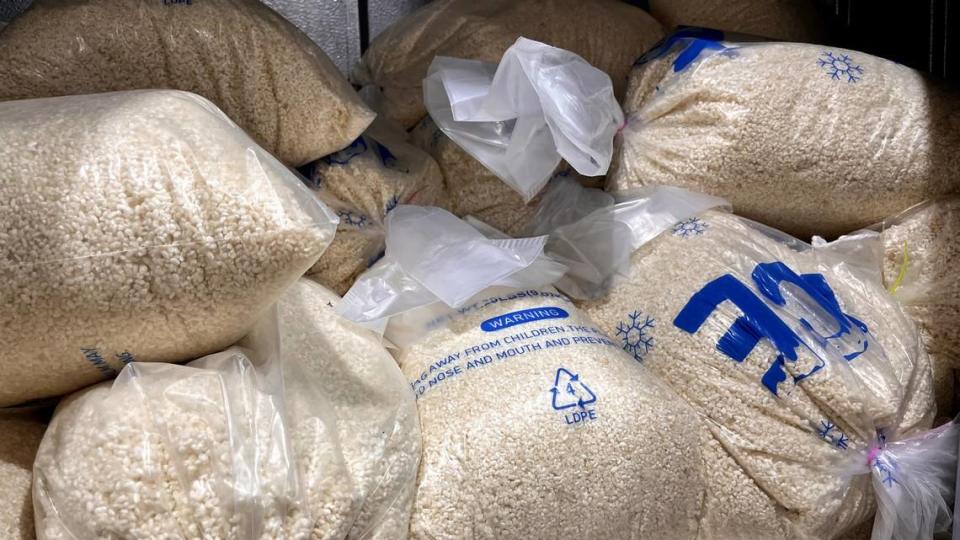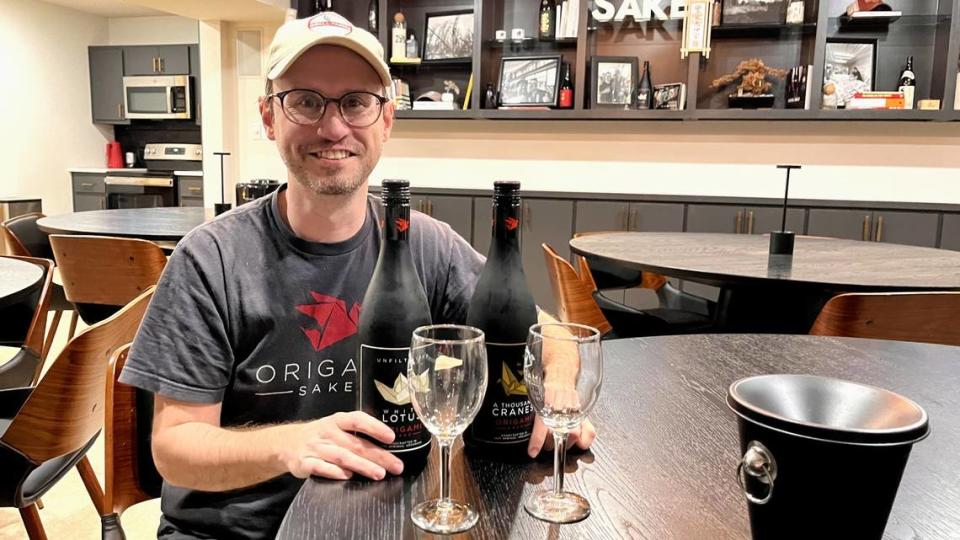Going with the grain: Southern sake brewery hopes to spark revolution in rice-drinking
Nearly every sake story in U.S.-based publications opens with a historical vignette.
Not one about the Japanese imperial court secretaries who 2,500 years ago interspersed their written reports on soil conditions and strange weather events with references to a beverage made from rice and mold. Instead, these stories start with the writer remembering when he was foolish enough to believe sake was always served summer sidewalk-hot in a handleless cup. Americans!
For Ben Bell of Origami Sake Company in Hot Springs, Arkansas, though, any discussion of sake begins with a moment located between those two hash marks on the global timeline.
Bell keeps a pair of empty wine bottles at Origami. The solar-powered brewery, which opened in 2023 in a former flour mill, has the capacity to annually produce 1 million liters of sake, which would make it by far the biggest sake producer in the country. (At this point, Origami’s scrappy crew is straining to fill its Northwest Arkansas orders, an unsurprising circumstance in an industry that classifies century-old breweries as upstarts. “Sake is complicated,” says Bell, who serves as vice president of operations.)
One of Bell’s spent bottles bears a Heitz Cellars label. The other once held Haut-Médoc from Margaux.
These are props that Bell uses when he tells brewery visitors about the Judgment of Paris, the legendary 1976 showdown between Napa Valley and Bordeaux wine makers. Following a blind tasting, French judges ruled the winners came from California. Americans!
Since then, the event has been relitigated, recreated and dramatized in two movies. Because while Gallo descendants and members of the UC Davis Viticulture department might want to argue otherwise, nothing changed the trajectory of American grown-and-made wine like the Judgment, which transformed fermented grape juice for the la-di-da set into a $79 billion business. These days, the average American drinks roughly 3 gallons of wine a year.
By comparison, even though sake continues to make inroads with the domestic drinking public, your per capita share is just a little more than one tablespoon.
Sake has crouched on the banks of the mainstream for decades, much as crickets have long been on the cusp of becoming a standard pantry item. “Sake is booming in America,” The New York Times announced in a 2023 article, citing import growth (relatedly, sake is cratering in Japan), retailer enthusiasm and a profusion of craft breweries, including Proper Sake in Nashville and North American Sake in Charlottesville.
Yet at Origami’s scale, there’s “us, them and another one,” according to Bell’s accounting. Without a Judgment of Paris-like tipping point, popularizing a category now represented on a mere 2% of U.S. restaurant menus could prove downright undoable.
Still, as the display wine bottles demonstrate, Bell and his business partner, CEO Matt Bell (no relation), plan to keep trying while they wait for the watershed. And at a time when their state is galloping off in a political direction away from New York City’s influential sake cognoscenti, they’re making Arkansas central to their marketing strategy.
‘Something new that no one’s on to yet’
Say “Hot Springs,” and people think of water, just as they know what to expect when they get to Butte, Montana. But the mineral-rich thermal waters that soothed President Harry Truman’s poker losses and failed to clear up Al Capone’s syphilis aren’t the same as the water that Mountain Valley Spring Water has been bottling in Hot Springs since 1871, and it’s not the water that goes into Origami’s sake. While Hot Springs’ groundwater is plentiful and clear, the Bells set up shop in the middle of Arkansas for another reason.
Sake consists of four ingredients: Water, koji, yeast and rice. With apologies to the chemists in the crowd, let’s focus on the rice, which is so abundant in Arkansas that some of it is shipped to China. Arkansas yearly produces more than 9 billion pounds of rice, or about half of the entire U.S. rice harvest.
Much of that rice gets drunk in the form of Budweiser beer, which has been made with Arkansas rice since 1876. Yet Anheuser-Busch only recently started playing up its purchasing record, printing up vinyl “Made with Arkansas rice” advertising banners for bars to hang alongside their dartboards.
Nevertheless, Ben Bell points out that the everyday guzzler isn’t going to get a surge of state pride by looking at a Bud can. By contrast, he says, with sake, “Rice is visible. It’s on our label. It’s our number-one talking point.”

Specifically, Origami uses rice from Isbell Farms, which has been cultivating Koshihikari rice — a short-grain varietal favored by Japanese sushi connoisseurs — since the 1990s. Around 2010, Chris Isbell set aside five acres to see whether he could best his previous agricultural feat, which so stunned Japanese eaters who believed Koshihikari couldn’t be grown off their island that tourists came to his farm by the busload.
“I don’t know good sake from bad sake. I just grow rice,” Isbell told an Arkansas Times reporter who in 2014 chronicled his successful Yamada Nishiki experiments.
Japan’s top sake makers pounced on Isbell’s rice, which fit beautifully into their brews. But it also squared with Ben Bell’s dream of turning his home state’s crop into the beverage he’d come to adore as a wine shop employee.
A sensitive kid from Sheridan, Arkansas, Bell had a musical streak and quick mind that intimidated his public boarding school classmates, including those who physically towered over him. After graduation, he enrolled at — and then flunked out of — Grinnell College, before moving back to Little Rock. He took a job at Colonial Wine & Spirits in 2005 because it sounded less taxing than landscaping.
He soon discovered that among wine geeks, “There’s always a desire to find something new that no one’s on to yet. Craft sake ended up becoming that thing to me.”
Over the next several years, Bell assembled a sake section for the store, wrote extensive sake lists for restaurants he ran and eventually apprenticed at a sake brewery in Japan. But making Arkansas sake lingered on his to-do list, as he told Isbell when Bell persuaded him to meet over catfish.
In 2017, Bell got serious about the project. He abandoned it two years later, exhausted by the challenges of starting a new business, moving to New York City to help manage Skurnik Wines’ Japanese portfolio. He had every intention of staying with the distributor when serial entrepreneur Matt Bell called to recruit him for Origami.
Bell demurred politely. He liked his work. He liked his salary. He liked the chopped cheese sandwiches at his neighborhood bodega.
His willpower faded when he got to Hot Springs.
“It did look like a building you could make sake in,” Bell said. “On the drive back to Little Rock, I was like, ‘Shit, I’m going to do this.’”

A taste only Arkansas can make
Wine grapes are famously malleable, developing different characteristics as the ambient temperature changes and nitrogen supply fluctuates. Rice isn’t quite so capricious. A quality varietal is essentially the same everywhere, year over year, and a decent sake brewer can smooth over any flavor deviations. In fact, that’s their job: Unlike wine makers who aim to showcase what a grape witnessed while on the vine, sake makers stay true to their labels’ signature styles.
“So, then, does sake have that sense of can-only-be-done-here terroir?” Bell’s former instructor and acknowledged sake savant, John Gauntner, asked in a 2014 essay. “I espouse that it does.”
As Gauntner sees it, sake terroir resides in the kura, or building, where it’s produced. That doesn’t mean the physical structure alone, although Gauntner maintains that sake made in an industrial-walled factory won’t taste exactly like sake brewed in a wooden hut. Rather, kura encompasses “the intention and personality of the toji (master brewer), and the nature of the kuramoto (brewery president).”
In other words, the Bells’ determination to celebrate Arkansas, and participate outwardly in Hot Springs’ current cultural renaissance, is what ultimately shapes the distinctive flavors of Origami’s two sakes: A fruity, acidic sake that Origami’s website suggests pairing with smash burgers, and a cloudy counterpart that Japanese sake snobs might reflexively reject as too rustic.
Their pro-Arkansas position has raised some eyebrows in progressive Northern cities where sake is starting to take hold. People who only know Arkansas as the place where one out of every four legislators meets the Institute for Research and Education on Human Rights’ criteria for “far-right extremist” aren’t sure what to make of its elected officials touring and touting Origami. But Ben Bell remembers an Arkansas that wasn’t so glaringly red; he isn’t ready to cede the state’s identity to archconservatives.
“We’re a big sense-of-place place,” said Bell, who’s endlessly frustrated by movie actors using generic Southern accents instead of narrowing their twangs to specific states. To that end, when representatives of sake equipment companies visit from Japan, Bell insists on taking them to Ward’s The Crawfish Hole, where the fried frog leg platters are trimmed with hushpuppies.
Of course, making Arkansas’ case to sake professionals is just half of Origami’s daunting task. To instigate a revolution that yields sake microbreweries in every sizable city and rows of sake on Kroger shelves, Origami has to pitch sake to Arkansans. “This is kind of the hard truth,” Bell said. “People have to taste it. It’s not going to become legitimate until the work of putting sake in front of people gets done.”
Pairings
So, I tasted it. Before my trip to Hot Springs, I asked Bell’s former Skurnik boss, Jamie Graves, to choose imported sakes to match with Arkansas’ most iconic foods. He was game, although he had a few questions about the list of dishes I emailed. “I’d be lying if I said I knew what fried pie is,” he wrote. “Just deep-fried…pie?” (He made the call for Hojo Biden, based on its caramel notes, but the name — which means “pastoral beauty” in Japanese — made me feel patriotic about illegally drinking it in a park with a Feltner’s Whatta-Burger apple pie.)
Not every pairing was persuasive. A swig of Gikyo Junmai Ginjo registered as harsh and alcoholic in the face of a McClard’s Half Spread, with the tamales’ tomato-based sauce blunting the promised hints of melon. On the savory side, I’d recommend instead picking up a bottle of Shinkame Junmai, which in its cohesive richness was a more flattering complement to fried pickles than the ranch dressing supplied by Ed Walker’s Drive-in in Fort Smith.
Judgment of Camden has a nice ring to it, doesn’t it? That Ouachita River railroad town — policed until March by the state’s oldest cop, 93-year-old Buckshot Smith — was the site of my sake tour’s apotheosis, where I drank Zaku ‘Miyabi no Tomo’ Junmai Ginjo, soft and clean as freshly laundered towels, with white cheese dip. The two wildly disparate items were remarkably harmonic.
Honestly, I didn’t want to stop snacking and sipping. That gave me plenty of time to think, and here’s where I landed: The tipping point for a beverage that stands to deepen the South’s complex and ongoing relationship with rice may not consist of the sake bombs being pushed at one end of the sophistication spectrum, or the tasting classes at the other. It might look a lot like a hot cup of something that Arkansans already love.
This story first appeared in The Food Section, a Charleston-based newsletter covering food and drink across the American South. To learn more about the James Beard Award-winning publication, visit thefoodsection.substack.com.

